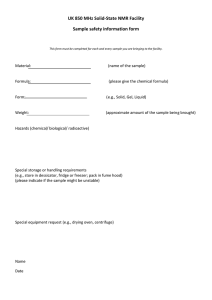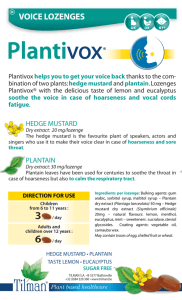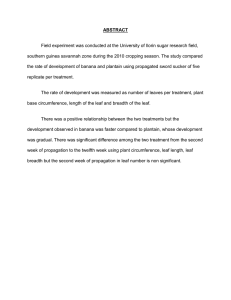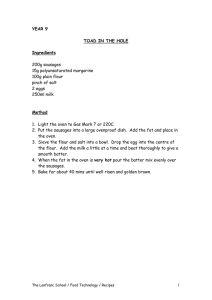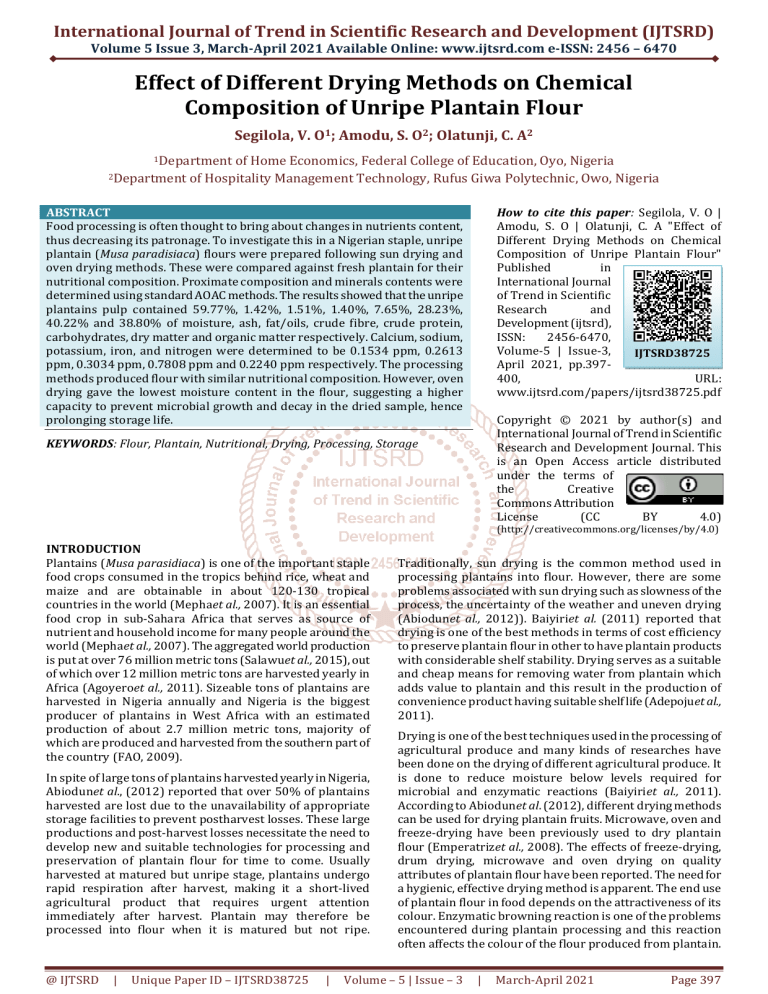
International Journal of Trend in Scientific Research and Development (IJTSRD)
Volume 5 Issue 3, March-April 2021 Available Online: www.ijtsrd.com e-ISSN: 2456 – 6470
Effect of Different Drying Methods on Chemical
Composition of Unripe Plantain Flour
Segilola, V. O1; Amodu, S. O2; Olatunji, C. A2
1Department
of Home Economics, Federal College of Education, Oyo, Nigeria
2Department of Hospitality Management Technology, Rufus Giwa Polytechnic, Owo, Nigeria
How to cite this paper: Segilola, V. O |
Amodu, S. O | Olatunji, C. A "Effect of
Different Drying Methods on Chemical
Composition of Unripe Plantain Flour"
Published
in
International Journal
of Trend in Scientific
Research
and
Development (ijtsrd),
ISSN:
2456-6470,
Volume-5 | Issue-3,
IJTSRD38725
April 2021, pp.397400,
URL:
www.ijtsrd.com/papers/ijtsrd38725.pdf
ABSTRACT
Food processing is often thought to bring about changes in nutrients content,
thus decreasing its patronage. To investigate this in a Nigerian staple, unripe
plantain (Musa paradisiaca) flours were prepared following sun drying and
oven drying methods. These were compared against fresh plantain for their
nutritional composition. Proximate composition and minerals contents were
determined using standard AOAC methods. The results showed that the unripe
plantains pulp contained 59.77%, 1.42%, 1.51%, 1.40%, 7.65%, 28.23%,
40.22% and 38.80% of moisture, ash, fat/oils, crude fibre, crude protein,
carbohydrates, dry matter and organic matter respectively. Calcium, sodium,
potassium, iron, and nitrogen were determined to be 0.1534 ppm, 0.2613
ppm, 0.3034 ppm, 0.7808 ppm and 0.2240 ppm respectively. The processing
methods produced flour with similar nutritional composition. However, oven
drying gave the lowest moisture content in the flour, suggesting a higher
capacity to prevent microbial growth and decay in the dried sample, hence
prolonging storage life.
Copyright © 2021 by author(s) and
International Journal of Trend in Scientific
Research and Development Journal. This
is an Open Access article distributed
under the terms of
the
Creative
Commons Attribution
License
(CC
BY
4.0)
KEYWORDS: Flour, Plantain, Nutritional, Drying, Processing, Storage
(http://creativecommons.org/licenses/by/4.0)
INTRODUCTION
Plantains (Musa parasidiaca) is one of the important staple
food crops consumed in the tropics behind rice, wheat and
maize and are obtainable in about 120-130 tropical
countries in the world (Mephaet al., 2007). It is an essential
food crop in sub-Sahara Africa that serves as source of
nutrient and household income for many people around the
world (Mephaet al., 2007). The aggregated world production
is put at over 76 million metric tons (Salawuet al., 2015), out
of which over 12 million metric tons are harvested yearly in
Africa (Agoyeroet al., 2011). Sizeable tons of plantains are
harvested in Nigeria annually and Nigeria is the biggest
producer of plantains in West Africa with an estimated
production of about 2.7 million metric tons, majority of
which are produced and harvested from the southern part of
the country (FAO, 2009).
In spite of large tons of plantains harvested yearly in Nigeria,
Abiodunet al., (2012) reported that over 50% of plantains
harvested are lost due to the unavailability of appropriate
storage facilities to prevent postharvest losses. These large
productions and post-harvest losses necessitate the need to
develop new and suitable technologies for processing and
preservation of plantain flour for time to come. Usually
harvested at matured but unripe stage, plantains undergo
rapid respiration after harvest, making it a short-lived
agricultural product that requires urgent attention
immediately after harvest. Plantain may therefore be
processed into flour when it is matured but not ripe.
@ IJTSRD
|
Unique Paper ID – IJTSRD38725
|
Traditionally, sun drying is the common method used in
processing plantains into flour. However, there are some
problems associated with sun drying such as slowness of the
process, the uncertainty of the weather and uneven drying
(Abiodunet al., 2012)). Baiyiriet al. (2011) reported that
drying is one of the best methods in terms of cost efficiency
to preserve plantain flour in other to have plantain products
with considerable shelf stability. Drying serves as a suitable
and cheap means for removing water from plantain which
adds value to plantain and this result in the production of
convenience product having suitable shelf life (Adepojuet al.,
2011).
Drying is one of the best techniques used in the processing of
agricultural produce and many kinds of researches have
been done on the drying of different agricultural produce. It
is done to reduce moisture below levels required for
microbial and enzymatic reactions (Baiyiriet al., 2011).
According to Abiodunet al. (2012), different drying methods
can be used for drying plantain fruits. Microwave, oven and
freeze-drying have been previously used to dry plantain
flour (Emperatrizet al., 2008). The effects of freeze-drying,
drum drying, microwave and oven drying on quality
attributes of plantain flour have been reported. The need for
a hygienic, effective drying method is apparent. The end use
of plantain flour in food depends on the attractiveness of its
colour. Enzymatic browning reaction is one of the problems
encountered during plantain processing and this reaction
often affects the colour of the flour produced from plantain.
Volume – 5 | Issue – 3
|
March-April 2021
Page 397
International Journal of Trend in Scientific Research and Development (IJTSRD) @ www.ijtsrd.com eISSN: 2456-6470
The browning reactions usually occur during processing
because of the activity of polyphenol oxidase that is also
known as tyrosinase (Adeniyiet al., 2009). It is therefore
essential to pretreat plantain slices during processing to
arrest the browning, which if not arrested may affect the
colour of the final product. Therefore, to intensify the use of
plantain flour in food products, it is necessary to establish
the best drying method to produce plantain flour of good
quality. The objectives of the study were to determine the
effect of drying methods on the chemical composition of
unripe plantain flours.
Values are means± standard deviation. The values in a row
followed by the same superscripts are not statistically
significantly different at a significance level of 5%
Materials and methods
Collection of Plantain: The matured unripe plantain fruits
for this work were purchased from the Teaching and
Research Farm of Rufus Giwa Polytechnic, Owo, Ondo State,
Nigeria. Plantain of the same variety and maturity level were
carefully selected.
The results of proximate analysis of fresh, sundried and
oven-dried samples are given below (Table 1). The result
showed that plantain contained appreciable amounts of
carbohydrates, whether fresh or processed. Moisture and the
protein content of plantain were lowered by the two drying
methods tested in this study. Crude fibre, carbohydrates, dry
matter, ash content and organic matter contents were higher
in the drying methods employed here. Decrease in these
macronutrients may be attributed to the application of heat.
Similar losses of these macronutrients after heat treatment
have been reported (Onuohaet al., 2014; Enomfon-Akpan
and Umoh, 2004; Morris et al., 2004). The application of heat
can be both beneficial and detrimental to nutrients. Heat
improves the digestibility of food, promotes palatability and
improves the keeping quality of food, making them safe to
eat. The heating process also results in nutrients’ losses by
inducing biochemical and nutritional variation in food
composition.
Preparation of Plantain flour: The selected plantains fruits
were processed in the Department of Food Science and
Technology Laboratory, Rufus Giwa Polytechnic, Owo, Ondo
State. The plantain fruits were washed, hand-peeled and
sliced using a plantain slicer in other to obtain slices of the
same thickness. The sliced plantain was divided into three
portions, two of the samples were then dried using solar and
oven drying methods while the last one was used as control
(fresh). They were then milled and stored in ziplock bags for
further analysis (Zakpaaet al., 2010).
Proximate Composition of the Plantain Flour
samples: The proximate composition of the samples were
done using the methods describe by AOAC (2005).
Mineral Composition of Plantain Flour Samples: Minerals
in the samples were determined using AOAC (2005)
methods. Into a digestion tube 1 g of the sample was
weighed, 15 ml of concentrated Nitric acid (HNO3) added to
each sample and digested for 30 min at 150 °C in a digester
in a fume chamber. The sample was digested until the
solution was pale yellow, and allowed to cool. 10 mL of
concentrated perchloric acid (70 % HClO4) was added and
the digestion continued at 200 °C until the solution was
colourless. After complete digestion, the solution was cooled
slightly and 80 ml of distilled water added. The mixture was
boiled for about 10 min and filtered through Whatman No.
42 filter paper into 250 ml volumetric flask. The solution was
then made to the mark with distilled water.
Determination of Ca, Na, K and Fe:The concentrations of
Ca, Na, K and Fe were determined using Atomic Absorption
Spectrophotometer (Spectra AA220FS Model). The mineral
contents in the samples were then calculated and results
expressed in part per million (ppm).
Results and Discussion
Table1: Proximate composition of fresh plantain,
sundried and oven dried unripe plantain flours
Oven-dried
Parameter
Fresh
Sun-dried
Sun-dried
Moisture
9.77±0.03a 9.09±0.01c 15.00±0.01b
Ash
1.42±0.01b 5.44±0.01a
4.80±0.01a
Fat
1.51±0.02a 1.55±0.01a
1.37±0.01b
Crude fibre
1.40±0.02b 10.11±0.01a 10.43±0.01a
Crude protein 7.65±0.01a 3.60±0.01b
3.34±0.01b
c
a
Carbohydrates 28.23±0.06 70.19±0.01 65.04±0.03b
Dry matter 40.22±0.03c 90.90±0.01a 84.99±0.01b
Organic matter 38.80±0.02b 85.46±0.01a 80.19±0.00a
@ IJTSRD
|
Unique Paper ID – IJTSRD38725
|
Table 2: Mineral composition of fresh unripe plantain,
sundried and oven dried unripe plantain flours.
Parameter
Fresh Oven-dried Sun-dried
Calcium (ppm)
0.1534
0.4229
0.5385
Sodium (ppm)
0.2613
0.7955
0.9108
Potassium (ppm) 0.3034
1.8905
0.8170
Iron (ppm)
0.7808
0.7963
0.0239
The apparent increase in carbohydrate, dry matter, organic
matter, ash and fibre contents observed in this study
following drying treatments could be because of the removal
of moisture that tends to increase the concentration of
nutrients (Morris et al., 2004). Processing has been reported
to increase carbohydrates availability in a more digestible
form (Emperatrizet al., 2008). These could explain the
significant difference (P<0.05) observed in the
carbohydrates content of processed samples (oven-dried
and sundried plantain flour).
The moisture content for the fresh plantain was determined
to be 9.77% in agreement with 9.4% and 9.612% reported
by Adepojuet al. (2012) and Agoyeroet al. (2011)
respectively. The moisture content of flour was determined
to be 9.09% (oven-dried) 15.01% (sundried) as compared to
11.03% (oven dried) and 13.00% (sundried) reported by
Agoyeroet al. (2011). These values were all significantly
different (P<0.05) from each other. Moisture content of food
or processed products gives an indication of its anticipated
shelf life. Low moisture content is a requirement for long
storage life. During storage, fungal growth is bound to be
observed on moist food samples. Fungal food contamination
could be a predisposing factor to food poisoning such as
aspergillosis. Since a well-dried food sample withstands
fungal and other microbial infestation better during storage,
oven dried flour gave lower residual moisture content, hence
should be preferred.
Fat, indicating the total lipid content of the plantain was
shown to be 1.51% (fresh), 1.37% (sundried) and 1.55%
(oven dried) (Table 1). Agoyeroet al. (2011) reported unripe
plantain fruit gives values as 2.75% (fresh), 1.38%
(sundried) and 1.57% (oven dried) while Adepojuet al.
(2012) reported 1.50% (fresh) and 3.90% (sundried). The
fresh and oven dried samples are not significantly different
Volume – 5 | Issue – 3
|
March-April 2021
Page 398
International Journal of Trend in Scientific Research and Development (IJTSRD) @ www.ijtsrd.com eISSN: 2456-6470
(P>0.05), but these are significantly different (P<0.05) from
the sun dried sample. These results agree. Variations could
be due to intensity of sunlight during the drying process,
extent of dryness because sun drying has no objective way of
assessment. The difference observed between sundried and
oven dried samples could be as a result of solar radiations
mediated oxidation of the composite lipids, especially the
unsaturated fatty acids thereby decreasing the overall crude
lipids content and quality. Nutrients have been reported to
be lost because of chemical changes such as oxidation. Lipid
oxidation is known to be increased by many factors such as
heat, sun light and radiations (Savage et al., 2002).
Minerals, being inorganic are not destroyed by heating. They
have low volatility compared to other food components. The
increased ash (Table 1) consequently calcium, sodium,
potassium (Table 2) observed in this study could be as a
result of the removal of moisture which tends to increase
concentration of nutrients per 100g of a food sample
(Morris, et al., 2004). This is evident by the percentage
organic matter content as it significantly differs (P<0.05)
between the different methods of treatment studied. Since
sun drying proceed slower than oven drying, it is obvious
that this prolonged drying period leaves room for several
biochemical reactions to occur freely under atmospheric
oxygen conditions (Wiriyaet al., 2009). This holds many
prospects in reducing the availability of the nutrient. The
decrease in the iron content of the sundried sample suggests
the anti-nutritional factors; oxalate and phytate
(unfortunately these were not determined in the present
study) could be present in the sample, thereby making the
mineral unavailable by forming complexes with them, as
reported by Enonfon-Akpan and Umoh, (2004).
The highest calcium value of 0.5385 ppm was observed from
the sundried sample while the fresh sample had the least
value, 0.1534 ppm (table 2). This is less than the
7566.53±0.93 mg/100kg reported by Salawuet al. 2015.
While the 0.44±0.00 ppm reposted by Onuohaet al. (2014) is
more than the fresh sample but less than the sundried
sample. Sodium followed a similar trend, being highest in
sundried sample (0.9108) and least (0.2613 ppm) in the
fresh sample. Potassium was highest in the oven dried
sample (1.8905 ppm), and lowest in the fresh sample
(0.3034 ppm). These values are all less than those reported
by Onuohaet al. (2014) and Salawuet al. (2015) for both
sodium and potassium. Iron had a similar pattern as
potassium. It was highest in the oven dried sample (0.7963
ppm) and lowest in the sundried sample (0.0239 ppm). The
rich content of calcium, sodium, iron and potassium in the
unripe plantain pulp could be attributed to factors such as
soil mineralization and fertilization. Variations in mineral
content in crops tend to be high, owing to varying degree of
ripeness, geographic and soil factors (Gibbon and Pain, 1985;
Morel et al., 1985; Zakpaaet al., 2010). These are thought to
play a role here as well. These show unripe plantain to be a
rich source of these minerals, especially potassium, sodium
and iron. Processing does not eliminate the mineral contents.
There was a significant (P<0.05) decrease in crude protein
content between the fresh sample and the dried ones. This
implies drying does not conserve proteins in plantain. The
crude protein content of fresh sample was determined to be
7.65% while 3.35% and 3.61% for the sundried and oven
dried samples respectively. These agree with the 3.6% and
3.86 protein in unripe plantain powder reported by Salawuet
al. (2015). In the presence of atmospheric oxygen, proteins
@ IJTSRD
|
Unique Paper ID – IJTSRD38725
|
contained in exposed tissues tend to react, forming several
intermediates which make the amino group of the amino
acids non bio-available. Decrease in protein content
probably occurred because of Millard reaction; which results
between carbohydrates and protein (Morriset al., 2004). It
could also be due to drying under elevated temperatures.
Similar losses of crude protein by the application of heat
have been reported (Hassan et al., 2007; Enonfon-Akpan and
Umoh, 2004; Morris et al., 2004). Application of heat can be
both beneficial and detrimental to nutrients. Heating
improves the digestibility of food, promotes palatability and
improves the keeping quality of food, making them safe to
eat.
Conversely, the heating process also result in nutritional
losses by inducing biochemical and nutritional variations in
food composition, especially sun heating. Since plantain are
consumed majorly for its energy content, this significant
decrease in crude protein due to processing does not
invalidate the need for food security by processing nor the
acceptance of this food sample in its processed form.
Moreover, the gain from energy seems to appreciate
significantly (P<0.05) (table 1).
The crude fibre was significantly different (P<0.05) between
the fresh sample and the processed samples (table 1). It was
determined to be 1.41% in agreement with the 1.40%
reported by Adepojuet al. (2012). Values for sundried and
oven dried were 10.43% and 10.12% respectively. These are
in agreement with the 10.43% and 10.11% reported for
sundried and oven dried respectively by Agoyeroet al.
(2011). Crude fibre represents the content of the nondigestible components of food, such as lignin, cellulose and
hemicelluloses. These are essential in animal nutrition, since
they enhance the transit time through the bowels, facilitates
bowels movement thus reducing the risk of colon cancer.
Ash is the inorganic residue after the water and organic
matter have been removed by burning a food sample. Ash
was significantly different (P<0.05) between the fresh
sample and the processed samples (table 1). It was
determined to be 1.43% from the fresh sample, which is in
agreement with the 1.40% reported by Adepojuet al. (2012).
The dry matter content was 40.23%, 90.91% and 84.99% for
fresh, oven dried and sundried samples respectively. Organic
matter content was 38.80%, 85.47%, and 80.19% for fresh,
sundried and oven dried samples respectively.
Conclusion and Recommendation
Based on the results obtained from the study, the two drying
methods were all good as they all yielded nutritional
constituents with minimal differences from the fresh sample.
However, to obtain fast drying, conserve protein and iron
content, the oven drying method though likely to be more
expensive is recommended, while the sun-drying method is
cheaply executed, takes a longer time and may be prone to
contaminations from microorganisms due to unhygienic
exposures.
Further studies could focus on the microbial contamination
of the flours from respective processing methods, fatty acids
profile and amino acid profile analysis. Moreover, the
reducing sugars content and the glycemic index of the flours
need to be examined. This will provide the necessary
information to adopt this food sample as a dietary source for
special nutritional cases, such as diabetics, depending on the
results obtained.
Volume – 5 | Issue – 3
|
March-April 2021
Page 399
International Journal of Trend in Scientific Research and Development (IJTSRD) @ www.ijtsrd.com eISSN: 2456-6470
References
[1] Morris, A. A., and Barnett, B. (2004). Effects of
processing on nutrient content of foods. Cajarticles,
37:160-164.
[2]
[3]
Savage, G. P., Dutta, P. C. and Rodriguez-Estrada, M. T.
(2002). Cholesterol oxides: Their occurrence and
methods to prevent their generation in foods. Asian
Practical J. Clin. Nutri. 11:72-78
Zakpaa, H. D., Mak-Mensah, E. E., and Adubofour, J.
(2010). Production and characterization of flour
produced from ripe “apam” plantain (Musa sapientum
L. var. paradisiaca French horn) grown in Ghana. J.
Agric. Biotech. Sus. Deve. 2(6):92-99
[4]
Wiriya, P., Paiboon, T., and Somchart, S. (2009). Effect
of drying air temperature and chemical pretreatments
on quality of dried chilli. Intern. Food Res. J. 16:4 – 7
[5]
Salawu, S. O., Shaibu, R., Afolabi, A. A., Boligo, A. A. and
Athayde, M. L. (2015). Nutraceutical potential and
sensory acceptability of unripe plantain-millet
Composite Flour Blends. Food Sci. Qual. Mngt., 39:8497
[6]
[7]
Emperatriz, P. D., Ronald, M., Elvina, P., and Mily, S.
(2008). Production and Characterization of unripe
plantain (Musa paradisiaca) flours Interciencia,
33:290 – 296
Baiyeri, K. P., Aba, S. C., Otitoju, G. T. and Mbah, O. B.
(2011). The effects of ripening and cooking methid on
minerial and proximate composition of plantain
(Musasp AAB cv “Agbagba”) fruit pulp. Afric. J.Biotech.
10(36): 6979 – 6984
[8]
AOAC (2005). Official Methods of Analysis,
Association of Official and Analytical Chemists,
Washington, D. C. USA 17thEdnpp 807 – 928
[9]
Adepoju, O. T., Sunday, B. E. and Folarami, O. A.
(2012). Nutrient composition and contributions of
plantain, (Musa paradisiaca) products to dietary
diversity of Nigerian consumers. Afric. J. Biotech.
11(71):13601-13605
@ IJTSRD
|
Unique Paper ID – IJTSRD38725
|
[10]
Agoyero, B. O., Akpiroroh, O. O., Osaweren, O. R. and
Owabor, C. N. (2011). The effect of various drying
methods on the nutritional composition of Musa
paradisiacal
Dioscorearotundata
and
Colocasiaesculenta. Asian J. Biochem. 6:458-464
[11]
Enomfon-Akpan, J. and Umoh, I. B. (2004). Effects of
heat and tretracycline treatments on the food quality
and
acridity
factors
in
cocoyam
Xanthosomasagittifolium (L) Schott. Pakistan J. Nutri.
3:240-243
[12]
FAO (2002). Human Vitamins and Mineral
requirements. United Nations Vaile DelleTerme di
Carcalla, 00100 Rome, Italy.
[13]
Gibbon, D. and Pain, A. (1985). Crops of the drier
regions of the Tropics. ECBS, pp 221 - 235
[14]
Morel, C., Blaskewitz, J., Fardeau, J.C. (1985).
Phosphorus supply to plants by soils with variable
phosphorus exchange. J. Soil Sc. 160 (6), 423-430
[15]
Onuoha, O. N., Eme, P. E., and Ekpo, U. E. (2014).
Chemical evaluation of unripe plantain dishes
commonly consumed by type 2 diabetics attending
the University of Uyo Teaching Hospital in AkwaIbom
State, Nigeria. Pak. J. Nutri. 13(6):331-334.
[16]
Adeniji, T. A., Sani, L. O., Barimalaa, I. S., and Hart, A. D.
(2009). Nutritional and antinutritional composition of
flour made from plantain and banana hybrid pulp and
peel mixture. Nig. Food J. 25(2): 234-241
[17]
Abiodun, A. A., Bolanle, O. O., and Sola, O. (2012).
Preliminary study on the development and evaluation
of instant pounded yam from Dicscoreaalata. Journal
of Applied Science Environmental Manage. 16(3): 287290.
[18]
Mepba, H. D., Eboh, L., and Nwaojigwa, S. U. (2007).
Chemical composition, functional and baking
properties of wheat-plantain composite flours. Afric. J.
Food Agric. Nutri. Dev. 7(1):1-22
Volume – 5 | Issue – 3
|
March-April 2021
Page 400


